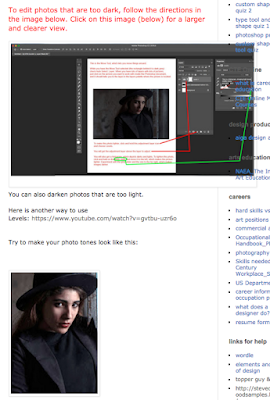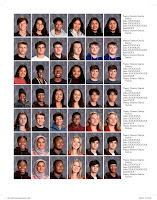I have photos from the Film Club trip to the Frist.
We are still putting photos that are too dark on our pages. Must be fixed in Photoshop before loading onto Yearbook pages.
If you have a club and need a printout to identify club members, here is what to do.
Dec 3
China talk on Dec10???????
Dec 2
•Finish clubs, organizations, etc. by break
•Sports
Basketball
Wrestling
•Are fall sports finished?
Past..........
Best buddies section? Best friends
Selfies?
Today_drama photos right after school. Who??????????
Health Science in gym on Tuesday
ADC block 4 Miranda
B&H block 2 Za'Kayla
HS block 1 Miranda
Fresh block 3
PLT pages due
November 4
Your teacher photos tagged
and in your folders
Only a few people did this.
Deadlines this Thursday
Who's Who?
Golf team photos in folders
Pages due next week?
Pep rally photos
I have some but need to Photoshop
Shoot in auto and use auto flash when you need to
Where are these photos going? Will they be tagged?
New assignment_everyone_due by Friday
Photo of teacher "teaching" in each of your classes
Be sure phone cams are on highest resolution
Be sure you can get your phone cam
photos into your eDesign folder
Using SD cards
http://hillwoodphoto1.blogspot.com/2018/08/sd-card-reader-slot.html
Phone to computer
http://hillwoodphoto1.blogspot.com/2018/08/transfer-photos-from-phone-to-computer.html
email a photo
http://stevecampbellhillwood.blogspot.com/2015/11/saving-as-jpeg.html
Fix in Photoshop
Load in your folder
Don't forget Halloween
I can also give you a point and shoot camera. Please don't put this off.
Homecoming candids, crowning, football action
https://drive.google.com/drive/mobile/folders/1Fc6xcGyh1QpuXK-PsLj6xjWOMxX4r5Go?usp=drive_open
Do you have this already Analese and Za'Kayla?
October 21 -25
Shafiqah needs Homecoming candids and teacher candids.
Who will help?
golf team shots
https://drive.google.com/file/d/1kCLWXqskWVlyIraQCd4Ae7hILc4wUz5T/view?usp=sharing
https://drive.google.com/file/d/11g-cpgXMySXFp1Tdqlchj4FY4bK5cvN5/view?usp=sharing
Due dates: November 7 and 22
Do you know your pages and when they are due?
October 16
•Should have a folder for everyone. In topics.
•Be sure you can adjust photo levels in Photoshop before you upload. Many photos are too dark.
Go to this link:
http://stevecampbellhillwood.blogspot.com/2019/10/photoshop-101.html
Just be sure you know how to place Photoshop and Chrome in your dock and that you can lighten or darken a photo. First part of link.
Then scroll down to this

•have you?
-->
•Test Senior Superlative ballots
October 15
Test superlative surveys
Homecoming and football
https://drive.google.com/drive/folders/1Fc6xcGyh1QpuXK-PsLj6xjWOMxX4r5Go
October 14
Cheerleader photos in Analese folder
Cross Country team photo in Cross Country
Golf need team and action
Link below has some cross country action and golf action, but not very good ones
https://drive.google.com/drive/folders/1Np5E7JmRQRejegu9uuqqmuYejd19VWHA
Should have a folder for everyone. In topics.
Be sure you can adjust photo levels in Photoshop before you upload. Many photos are too dark.
Go to this link:
http://stevecampbellhillwood.blogspot.com/2019/10/photoshop-101.html
Just be sure you know how to place Photoshop and Chrome in your dock and that you can lighten or darken a photo. First part of link.
Then scroll down to this

have you?
-->

Thursday, October 3,
during PLT....Cross Country photo.
Location:
Exact time:
Contact: Ms. Kirchhoff
Uploading photos
-->
We are still putting photos that are too dark on our pages. Must be fixed in Photoshop before loading onto Yearbook pages.
If you have a club and need a printout to identify club members, here is what to do.
Dec 3
China talk on Dec10???????
Dec 2
•Finish clubs, organizations, etc. by break
•Sports
Basketball
Wrestling
•Are fall sports finished?
Past..........
Best buddies section? Best friends
Selfies?
Today_drama photos right after school. Who??????????
Health Science in gym on Tuesday
ADC block 4 Miranda
B&H block 2 Za'Kayla
HS block 1 Miranda
Fresh block 3
PLT pages due
November 4
Your teacher photos tagged
and in your folders
Only a few people did this.
Deadlines this Thursday
Golf team photos in folders
Pages due next week?
Pep rally photos
I have some but need to Photoshop
Shoot in auto and use auto flash when you need to
Where are these photos going? Will they be tagged?
New assignment_everyone_due by Friday
Photo of teacher "teaching" in each of your classes
Be sure phone cams are on highest resolution
Be sure you can get your phone cam
photos into your eDesign folder
http://hillwoodphoto1.blogspot.com/2018/08/sd-card-reader-slot.html
Phone to computer
http://hillwoodphoto1.blogspot.com/2018/08/transfer-photos-from-phone-to-computer.html
email a photo
http://stevecampbellhillwood.blogspot.com/2015/11/saving-as-jpeg.html
Fix in Photoshop
Load in your folder
Don't forget Halloween
I can also give you a point and shoot camera. Please don't put this off.
Homecoming candids, crowning, football action
https://drive.google.com/drive/mobile/folders/1Fc6xcGyh1QpuXK-PsLj6xjWOMxX4r5Go?usp=drive_open
Do you have this already Analese and Za'Kayla?
October 21 -25
Shafiqah needs Homecoming candids and teacher candids.
Who will help?
golf team shots
https://drive.google.com/file/d/1kCLWXqskWVlyIraQCd4Ae7hILc4wUz5T/view?usp=sharing
https://drive.google.com/file/d/11g-cpgXMySXFp1Tdqlchj4FY4bK5cvN5/view?usp=sharing
Due dates: November 7 and 22
Do you know your pages and when they are due?
October 16
•Should have a folder for everyone. In topics.
•Be sure you can adjust photo levels in Photoshop before you upload. Many photos are too dark.
Go to this link:
http://stevecampbellhillwood.blogspot.com/2019/10/photoshop-101.html
Just be sure you know how to place Photoshop and Chrome in your dock and that you can lighten or darken a photo. First part of link.
Then scroll down to this

•have you?
-->
•Test Senior Superlative ballots
October 15
Test superlative surveys
Homecoming and football
https://drive.google.com/drive/folders/1Fc6xcGyh1QpuXK-PsLj6xjWOMxX4r5Go
October 14
Cheerleader photos in Analese folder
Cross Country team photo in Cross Country
Golf need team and action
Link below has some cross country action and golf action, but not very good ones
https://drive.google.com/drive/folders/1Np5E7JmRQRejegu9uuqqmuYejd19VWHA
Should have a folder for everyone. In topics.
Be sure you can adjust photo levels in Photoshop before you upload. Many photos are too dark.
Go to this link:
http://stevecampbellhillwood.blogspot.com/2019/10/photoshop-101.html
Just be sure you know how to place Photoshop and Chrome in your dock and that you can lighten or darken a photo. First part of link.
Then scroll down to this

have you?
-->

Thursday, October 3,
during PLT....Cross Country photo.
Location:
Exact time:
Contact: Ms. Kirchhoff
Watch eDesign help
Tagging Photos
sept 25.....
sort through Lifetouch photos to find photos of Hillwood teachers and staff
be sure you can log in to eDesign
sept 24.....
I should have already told you this, but.......
You may not go to another PLT unless a teacher requests you.
Always ask before you take photos of anyone for the yearbook.
In a situation like clubs, organizations, teacher classrooms, etc., you should probably set up photos with the teacher or sponsor at least 24 hours in advance.
Definitely set up any photos in the library ahead of time.
Get permission from Ms. Strickland or Ms. Biggs to go to the library during PLT
Delete any photos taken in the library yesterday.
My Fault..........
class counts as of September 18_2019
12 276
11 308
10 309
9 345
What is a yearbook?
to do today:
Take pics in art gallery
Measure volleyball, football and cheer photo frame (inside)
•Underclass photo proofs_find students who paid for photos and get photos to them
•sign up seniors
•signs
Senior Photos (add arrows)
Backstage Auditorium Entrance
•staff logins
•Get Chrome as browser
•log in to eDesign
•superlatives
past:
Ladder diagram and or assignments_Analese (if software will load)
Inventory if Victoria is here
Faculty yearbook section information updates_Z
Distribute student photos to students
Sign contract
Get log in for eDesign on line
Get Chrome as browser
Work on getting cameras
Get cameras and charge them. Get chargers at end of meeting.
Yearbook passes _ volunteer to be in charge?
Get and check your SD cards
Make a folder and file it in filing cabinet
Log in
Names in eDesign
Pick a fall sport if you want one.
Fall team photos on September 12_football and cheerleaders.
You could double check with Coach Moore and Ms. Lange.
Contact coaches to see if they want to schedule photos. I will probably take these and coaches were sent emails.
Senior Superlative team leader_Eriana
Superlative categories
Nomination forms
Nomination forms delivered
Nominations counted_SGA? No seniors count ballots
Final ballots
Superlatives photographed by October 11
Editors
Analese
Zoe
Za'Kayla
Photo editor?????
What I Want You to Know or Do:
- Take photos that are well focused
- Take photos that are well composed (rule of thirds)
- Take photos that show the story of the school year
- Use and understand page layout software
- Listen
Do you really want to be here?
• No grade for this class, but Yearbook Staff looks very impressive on resume´s
• This is not a "chill" class. If you are using your computer. your use should be school work.
So.........
Do you really want to be here?
Contract
Details, details, details. You are responsible for your page—every word, every photo, every mistake is your responsibility.
But.........feel free to ask for help during daily meetings. For example, "I need someone to take Freshman football action shots for me."
Please_no visitors
Teams & responsibilities
• Classes: seniors, juniors, sophomores, freshmen
• Photographing the entire school
Miranda Dozier
• Deliveries, teaching staff contact, organization, deliver class photos, upgrade the appearance of the school
• New Team: Coach Tinsley's book
Be a yearbook team - there is one team, the staff, and there are other teams, with individual members.
Never ask me this question: "Where are my pictures?"
Never ask me this question: "What is my assignment?"
Back up every day.
Log out every day.
Use your passes wisely. Do not interrupt classes. Be sensitive regarding hanging out in the library.
Make individual file folders. Write out your assignment and keep it in your folder, in a file cabinet.
Cameras (end of class if we have time):
You will be assigned a camera (usually daily) and an SD card(s). If you lose or break the camera, you are expected to replace it with a new camera, as good or better than the one assigned to you.
Keep the camera and index card with your name on it in the correct zip-lock bag.
Leave the camera in this classroom unless you must keep it overnight.
Your SD card should be
1. in the camera,
2. in a computer or card reader for uploading, or
3. in an envelope in the file cabinet.
Who has digital cameras?
Shoot photos & get names, especially of people you do not know.
A theme? Be sure it works in every section.
Assign sports. Give out sports assignments sheets.
Ladder diagram
Set page deadlines and remind staff
Register staff in eDesign
Typefaces and point sizes
